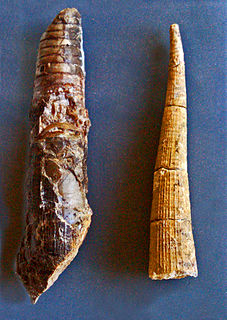Related Research Articles

Endocerida is an extinct nautiloid order, a group of cephalopods from the Lower Paleozoic with cone-like deposits in its siphuncle.

Orthoceratidae is an extinct family of actively mobile carnivorous cephalopods, subclass Nautiloidea, that lived in what would be North America, Europe, Asia, Africa, and Australia from the Ordovician through Triassic from 490—203.7 mya, existing for approximately 286.4 million years .
Cameroceras is a genus of extinct, giant orthoconic cephalopod that lived mainly during the Ordovician period. It first appears during the middle Ordovician, around 470 million years ago, and was a fairly common component of the fauna in some places during the period, inhabiting the shallow seas of Laurentia, Baltica and Siberia. Its diversity and abundance became severely reduced following the Ordovician–Silurian extinction events, and the last remnants of the genus went extinct sometime during the Wenlock.
Armenoceras is a genus of actinocerid nautiloid cephalopods whose fossils ranged from the late Whiterockian Stage in the early Middle Ordovician, through the remainder of the period and on into the Upper Silurian. It is the type genus of the family Armenoceratidae.
The Actinocerida are an order of generally straight, medium to large cephalopods that lived during the early and middle Paleozoic, distinguished by a siphuncle composed of expanded segments that extend into the adjacent chambers, in which deposits formed within contain a system of radial canals and a narrow space along the inner side of the connecting ring known as a paraspatium. Septal necks are generally short and cyrtochoanitic, some being recumbent, some hook shaped. Most grew to lengths of about 60 to 90 cm but some, like the Huroniidae of the Silurian grew significantly larger.
Anthoceras is a genus of straight, annulated, proterocamerioceratids from the Lower Ordovician, found in North America, NW Australia, and Siberia. The cross section is circular, the siphuncle moderately large, and marginal. Segments are constricted ; septal necks hemichoantici to subholochoantic ; connecting rings thick. Endocones are long and slightly asymmetric.
The Ellesmeroceratidae constitute a family within the cephalopod order Ellesmerocerida. They lived from the Upper Cambrian to the Lower Ordovician. They are characterized by straight and endogastric shells, often laterally compressed, so the dorso-ventral dimension is slightly greater than the lateral, with close spaced sutures having shallow lateral lobes and a generally large tubular ventro-marginal siphuncle with concave segments and irregularly spaced diaphragms. Connecting rings are thick and layered, externally straight but thickening inwardly with the maximum near the middle of the segment so as to leave concave depressions on internal siphuncle molds. Septal necks are typically orthochoanitic but vary in length from almost absent (achoanitic) to reaching halfway to the previous septum (hemichoanitic) and may even slope inwardly (loxochoanitic).
The Reudemannoceratidae are the ancestral and most primitive of the Discosorida, an order of cephalopods from the early Paleozoic. The Reudemannoceratidae produced generally medium-sized endogastric and almost straight shells with the siphuncle slightly ventral from the center.

Kionoceras is an extinct nautiloid cephalopod genus included in the orthocerid family Kionoceratidae with scattered worldwide distribution from the Middle Ordovician to the Lower Permian. Kionoceratids are orthocerids with prominent longitudinal ornamentation on their shells, sometimes augmented by secondary transverse ornamenttion. Orthocerids are, of course, prehistoric nautiloides with generally straight and elongate shells, mostly with central or subcentral siphuncles.
The Genus Hemichoanella is a small, extinct, orthoconic nautiloid cephalopod from the Lower Ordovician of Western Australia assigned to the orthoceratoid family, Baltoceratidae. Hemichoanella and the Baltoceratidae are part of the subclass of once diverse and numerous shelled cephalopods known as the Nautiloidea.
Baltoceratidae is an extinct family of orthoconic cephalopods belonging to the subclass Nautiloidea endemic to what would be Asia, Australia, Europe, North America, and South America during the Ordovician living from about 480–460 mya, existing for approximately 20 million years .

Proteoceratidae is an extinct family of actively mobile aquatic carnivorous cephalopods belonging to the subclass Orthoceratoidea endemic to what would be Asia, Australia, Europe, South America and North America during the Ordovician living from 490—445.6 Ma, existing for approximately 44.4 million years .

Orthoceratoidea is a subclass, formerly considered an infraclass or a superorder, that comprises Cephalopoda orders that have orthoconic to slightly cyrtoconic shells and central to subcentral siphuncles in which there may be internal deposits. Currently, Orthoceratoidea comprises the orders Dissidocerida, Ascocerida, Pseudorthocerida, Lituitida and Orthocerida.
Nybyoceras is an actinocerid genus assigned to the Armenoceratidae and similar to Armenoceras except for having a siphuncle close to the ventral side of the shell.
Campendoceras is a genus of proterocameroceratids from the Lower Ordovician of NW Australia and possibly Estonia that can be recognized by its slender, weakly endogastric, longiconic and annulate shell and large marginal siphuncle that contains endocones.
Proterocameroceras is an early Endocerid from the upper Lower Ordovician belong to the Proterocameroceratidae, characterized by a rather large, straight, longiconic shell, short chambers, generally straight sutures, and large ventral siphuncle with short septal necks, thick complex connecting rings, and endocones with three endosiphuncular blades toward the apex.
Hardmanoceras is a Tarphycerid genus belonging to the Trochilidae from the upper Lower Ordovician to possibly the lower Middle Ordovician, found in Western Australia. Hardmanoceras is like Discoceras but prominently ribbed and with a depressed whorl section. The body, or living, chamber is long, 1 1/8 volutions long. The ultimate portion is slightly divergent, not an uncommon characteristic of tarphycerids.

Curt Teichert was a German-American palaeontologist and geologist, noted for his contributions to geology, paleozoic stratigraphy and paleontology, Cephalopoda, ancient and modern reefs, and correlation, the matching of strata of the same age in different locations.

Armin Aleksander Öpik was an Estonian paleontologist who spent the second half of his career at the Bureau of Mineral Resources in Australia.
Selkirkoceras is a genus of armonoceratid cephalopods similar to Kochoceras of the Actinoceratidae, but with recumbent septal necks. The first siphuncular segment is large, broad, and blunt.
References
- Curt Teichert, 1964. Endoceratoidea. Treatise on Invertebrate Paleontology, Part K. Geol Soc. of America and Univ of Kansas press. Teichert and Moore (eds)
- Teichert and Glenister 1954 . Early Ordovician cephalopod fauna from northwestern Australia. Bulletins of American Paleontology 35 (150): 7–112.